A
Auto Express
Guest
The Ford Fiesta has a long but complicated history when it comes to performance derivatives. Over the course of almost four decades hot Fiestas have appeared under various naming strategies. Sub-par RS Turbo and mild Zetec S cars have been and gone, and while XR2 and XR2i badged Fiestas lay claim to being icons, it’s the more recent ST badged Fiestas have really put Ford’s hot supermini on the map.
The first Fiesta ST arrived in 2005 based on the fifth-generation Fiesta supermini - known as the Mk6 in the UK – and packing 150bhp from a naturally aspirated 2.0-litre engine. Although the Mk7 Fiesta arrived in 2008, fast Ford fans had to wait until 2013 for another ST version. With up to 197bhp on overboost from a turbocharged 1.6-litre four-cylinder engine, sweet handling, a superb chassis, a tactile gearbox and an enticing price tag compared to rivals, it quickly established itself as the hot supermini benchmark.
Fast-forward to the present day and the third Fiesta to wear the ST badge arrived just a year after the standard Mk8 car. A rival for the Volkswagen Polo GTI and MINI Cooper S, along with the now out-of-production Peugeot 208 GTi and Renault Clio RS, the car’s ethos remains much the same, but there’s a big change under the bonnet. This is a three-cylinder hot hatch, its new 1.5-litre unit heavily turbocharged to make up for a lack of capacity. It’s also available as a five-door model for the first time.
Ford continues to offer the Fiesta ST in three trim levels, although there's no longer an entry-level ST-1 model. Instead, the ST-2 and ST-3 now sit below the ST Ford Performance Edition. All versions get a special bodykit, subtly sportier than the one found on ST-Line Fiestas, plus additional ST touches in the cabin alongside Recaro sports seats. ST-2 cars are fitted with 17-inch wheels, air conditioning, cruise control, selectable drive modes and a 8.0-inch SYNC3 touchscreen with Apple CarPlay and Android Auto as standard.

Ford Fiesta ST - rear tracking

Ford Fiesta ST - rear

Ford Fiesta ST - front light
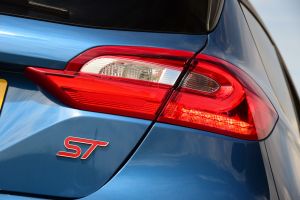
Ford Fiesta ST - rear light

Ford Fiesta ST - wheel

Ford Fiesta ST - dash

Ford Fiesta ST - steering wheel detail

Ford Fiesta ST - transmission
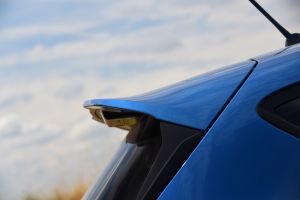
Ford Fiesta ST - rear spoiler

Ford Fiesta ST - rear static

Ford Fiesta ST - front cornering
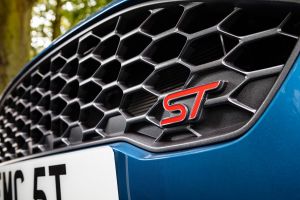
Ford Fiesta ST - grille
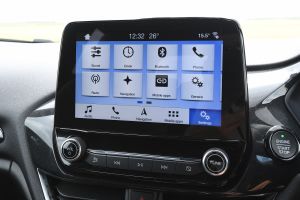
Ford Fiesta ST - infotainment

Ford Fiesta ST - front tracking

Ford Fiesta ST - front action

Ford Fiesta ST - front static
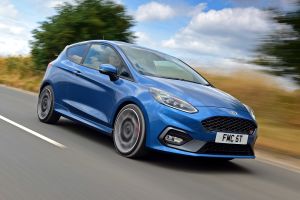
Ford Fiesta ST - front

Ford Fiesta ST - full front
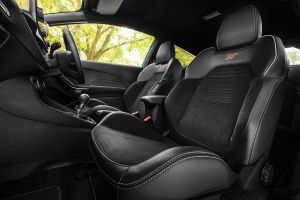
Ford Fiesta ST - front seats

Ford Fiesta ST - dials
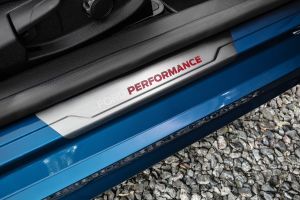
Ford Fiesta ST - sill
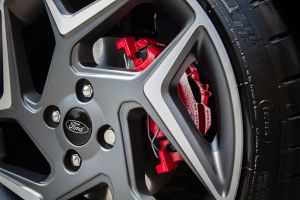
Ford Fiesta ST - brake caliper

Ford Fiesta ST - rear cornering

Ford Fiesta ST - rear action
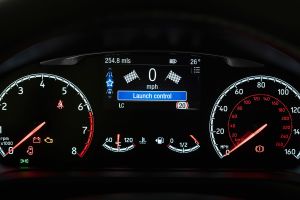
Ford Fiesta ST - launch control
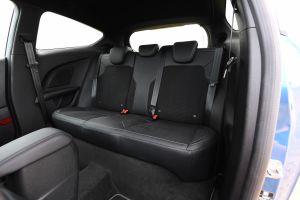
Ford Fiesta ST - rear seats

Ford Fiesta ST - seat detail
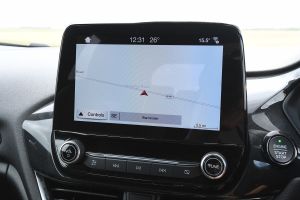
Ford Fiesta ST - sat-nav
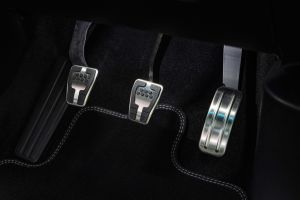
Ford Fiesta ST - pedals

Ford Fiesta ST - exhaust

Ford Fiesta ST - rear
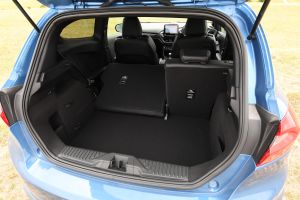
Ford Fiesta ST - boot
ST-3 and ST Ford Performance Edition cars are equipped with the ST Performance pack as standard (optional for ST-2 versions), which features a Quaife limited slip differential and launch control function.
ST-3 trim adds 18-inch alloys, Recaro leather-trimmed sports seats, a B&O premium audio system, heated front seats and wireless smartphone charging, while the Performance Edition includes lowered suspension, unique orange paint and performance alloys in a Magnetite finish.
Ford had a huge task on its hands to follow up the old Fiesta ST, a car which ranked consistently as one of, if not the, best hot superminis on sale for the entirety of its five-year lifespan. By and large its performance division has delivered once again. The new Fiesta ST changes recipe significantly with the adoption of three-cylinder power and it’s not quite as hard-edged as before with a more pliant ride.
Importantly though it still shines as a no nonsense hot hatch package, delivering on performance, agility, honest driving fun and value for money. The Fiesta ST ticks all the right boxes and largely avoids the superficial ones.
The old Ford Fiesta ST was always going to be a hard act to follow, and with such a substantial change under the bonnet, Ford has taken the opportunity to reconfigure the Fiesta ST’s character a bit.
Open the door and it all feels familiar – you’ll climb into deep, figure hugging Recaro bucket seats that feel huge in the cockpit. Fire up the Fiesta though, and you’re immediately introduced to the main event: the engine.
With three cylinders on board rather than four the engine note has changed drastically, though Ford’s engineers have attempted to compensate for the loss of a cylinder. Unlike the outgoing car with its predisposition to rev freely, the new Fiesta ST’s engine note is much bassier, and the torque curve means there’s little to gain from pushing it beyond 5,500rpm. The exhaust now crackles when the car is toggled into its Sport or Race driving modes though, and the Fiesta ST is much more vocal from outside – you’ll definitely notice one passing.
Overall it’s a brilliantly punchy unit with more torque than before, mated to a six-speed manual gearbox as slick in operation as you’d hope it to be. The Fiesta’s steering remains sharp and nimble, creating the desired impression of an agile, small car with bags of grip. There’s less jarring through the wheel on rough surfaces, but it’s just not quite as communicative or natural feeling as the setup in the older car.
The softer steering is joined in the ST by a more supple suspension setup. On the face of it, the alterations impress and this is a much more comfortable car, both around town and on long journeys, than before. The new car doesn’t feel quite as raw and connected with the road as its crashier predecessor, but the ride is still firm, composed and ensures the car flows down a typical B-road superbly.
The Fiesta ST is the best in class in terms of ride and handling balance, thanks mainly to its brilliant damping. The system is called Ride Control 1, and it’s a passive setup that can firm things up during hard cornering but ease off when less demand is placed on the car’s grip reserves. Edge the Fiesta ST into one of its racier driving modes, and the ESC will relinquish a bit of its hold on the chassis and throttle allowing some slides.
You can now skip the Fiesta’s decent torque vectoring setup and opt for a proper mechanical limited slip differential, too - thus unlocking even more front-end grip and adding another dimension to the car’s stellar handling characteristics. The Performance Pack it is grouped into also includes launch control and a shift prompt light on the dashboard.
Engines, 0-60 acceleration and top speed
A new 1.5-litre three-cylinder turbo with cylinder deactivation technology makes its way under the Fiesta ST’s bonnet and is a key element of the overall experience. It’s bassy and sounds distinctly more imposing than the old 1.6-litre on start up. Overall, it makes much more noise, even though it doesn’t rev out quite as hard at the top end.

Ford Fiesta ST - rear tracking

Ford Fiesta ST - rear

Ford Fiesta ST - front light

Ford Fiesta ST - rear light

Ford Fiesta ST - wheel

Ford Fiesta ST - dash

Ford Fiesta ST - steering wheel detail

Ford Fiesta ST - transmission

Ford Fiesta ST - rear spoiler

Ford Fiesta ST - rear static

Ford Fiesta ST - front cornering

Ford Fiesta ST - grille

Ford Fiesta ST - infotainment

Ford Fiesta ST - front tracking

Ford Fiesta ST - front action

Ford Fiesta ST - front static

Ford Fiesta ST - front

Ford Fiesta ST - full front

Ford Fiesta ST - front seats

Ford Fiesta ST - dials

Ford Fiesta ST - sill

Ford Fiesta ST - brake caliper

Ford Fiesta ST - rear cornering

Ford Fiesta ST - rear action

Ford Fiesta ST - launch control

Ford Fiesta ST - rear seats

Ford Fiesta ST - seat detail

Ford Fiesta ST - sat-nav

Ford Fiesta ST - pedals

Ford Fiesta ST - exhaust

Ford Fiesta ST - rear

Ford Fiesta ST - boot
Ford quotes 197bhp for the unit, which is the same figure as the previous car on overboost. Importantly though, there is more torque. 290Nm is on offer, and that’s an impressive figure in a car of the Fiesta’s size which means it feels on edge and urgent when the turbo is in play. Power is delivered low down and stays on call until around 5,500rpm, with the 6,000rpm redline arriving not soon after.
The Fiesta’s downsized engine, compared to the four-cylinder norm in this class, means that it boasts some impressive fuel economy figures, and in the real world it’ll definitely be cheaper to run than its predecessor. Officially, Ford claims that the new Fiesta ST will return 40.4mpg, with CO2 emissions of 158g/km. In real world conditions, and as we’ve found on test, fuel economy in the mid 30s is what you can expect.
A cylinder deactivation system is present on this car. This means that, given the chance, the new engine will actually shut down into two-cylinder mode. While that might sound a little off-putting if your primary concern is driving fun and instant response from the unit, you’ll be pleased to hear that the deactivation and reactivation of the third cylinder is seamless and virtually undetectable from behind the wheel.
Insurance groups
The Fiesta ST occupies insurance group 28. That puts it on par with the MINI Cooper S, but two above the latest Volkswagen Polo GTI. Regardless, it still should be reasonable to insure thanks to the competitive list price of the car.
Depreciation
Sadly, one area where the new Fiesta ST doesn’t quite stand out is its residual value. Our experts anticipate that it’ll retain around 44% of its value over three years and 36,000 miles. You’re likely to lose less money with a MINI Cooper S.
The Ford Fiesta is one of the most common sights on British roads, and by and large the ST version will slip by unnoticed, as its sporty design shares much in common with the popular ST-Line version of the regular car. There’s a honeycomb grille up at the front with unmistakable red ST badging, but aside from that the only noticeable changes are black inserts on the sporty front bumper, the ST’s unique alloy wheel design, a lower stance, a subtly different rear bumper and a twin exit exhaust setup.
Access the cabin and the changes are more evident. You can’t miss the huge Recaro bucket style sports seats, while elsewhere there’s faux carbon-fibre trim on the dashboard, an ST emblazoned steering wheel, a chrome effect gear lever and bespoke instruments.

Ford Fiesta ST - rear tracking

Ford Fiesta ST - rear

Ford Fiesta ST - front light

Ford Fiesta ST - rear light

Ford Fiesta ST - wheel

Ford Fiesta ST - dash

Ford Fiesta ST - steering wheel detail

Ford Fiesta ST - transmission

Ford Fiesta ST - rear spoiler

Ford Fiesta ST - rear static

Ford Fiesta ST - front cornering

Ford Fiesta ST - grille

Ford Fiesta ST - infotainment

Ford Fiesta ST - front tracking

Ford Fiesta ST - front action

Ford Fiesta ST - front static

Ford Fiesta ST - front

Ford Fiesta ST - full front

Ford Fiesta ST - front seats

Ford Fiesta ST - dials

Ford Fiesta ST - sill

Ford Fiesta ST - brake caliper

Ford Fiesta ST - rear cornering

Ford Fiesta ST - rear action

Ford Fiesta ST - launch control

Ford Fiesta ST - rear seats

Ford Fiesta ST - seat detail

Ford Fiesta ST - sat-nav

Ford Fiesta ST - pedals

Ford Fiesta ST - exhaust

Ford Fiesta ST - rear

Ford Fiesta ST - boot
Sat-nav, stereo and infotainment
The ST-2 comes equipped with the SYNC 3 8.0-inch touchscreen display boasting Apple CarPlay and Android Auto as standard, along with seven speakers and and two USB ports for smartphone connectivity.
The system is responsive, clear and bright, so it’s pretty easy to use. As it’s a ‘floating’ style setup there’s nowhere to rest and steady your hand if you use it on the move, but all of the buttons and icons on screen are big and hard to miss. The menu layout is logical and sensible, but there’s no physical home button to bring the setup back to square one – instead, it’s an icon buried in the top left hand corner. If you opt for navigation, maps are displayed sharply and accurately, and are very easy to read.
The Ford Fiesta ST is credible as a performance car, and it should prove to be a fairly straightforward supermini to live with day to day too, given the base car has already proven itself in this regard. The availability of a five-door ST is a welcome addition, and it’s probably the Fiesta we’d recommend – so long as you don’t mind spending a bit more cash and sacrificing a little style.
Size
The Fiesta is 4,068mm long, 1,469mm tall and 1,941mm wide, so it’s right on the money for a car in this segment, and you’ll feel little difference between the Fiesta and the rest of the class. It’s not as wide as the Polo GTI though, which feels a bit more spacious inside thanks to its additional shoulder room.
Leg room, head room & passenger space
The Fiesta ST boasts a decent amount of room overall. Up front driver and passenger will find plenty of space, and visibility all around is good. The only sub-optimal areas being the slim rear window and thick C-pillars that hinder the view out to the rear. We’ve found the Fiesta to boast more room in the rear than the MINI Cooper S, though compared to the regular version of the supermini a little legroom in the back is lost to those large Recaro seats up front. ISOFIX points for child seats are equipped.

Ford Fiesta ST - rear tracking

Ford Fiesta ST - rear

Ford Fiesta ST - front light

Ford Fiesta ST - rear light

Ford Fiesta ST - wheel

Ford Fiesta ST - dash

Ford Fiesta ST - steering wheel detail

Ford Fiesta ST - transmission

Ford Fiesta ST - rear spoiler

Ford Fiesta ST - rear static

Ford Fiesta ST - front cornering

Ford Fiesta ST - grille

Ford Fiesta ST - infotainment

Ford Fiesta ST - front tracking

Ford Fiesta ST - front action

Ford Fiesta ST - front static

Ford Fiesta ST - front

Ford Fiesta ST - full front

Ford Fiesta ST - front seats

Ford Fiesta ST - dials

Ford Fiesta ST - sill

Ford Fiesta ST - brake caliper

Ford Fiesta ST - rear cornering

Ford Fiesta ST - rear action

Ford Fiesta ST - launch control

Ford Fiesta ST - rear seats

Ford Fiesta ST - seat detail

Ford Fiesta ST - sat-nav

Ford Fiesta ST - pedals

Ford Fiesta ST - exhaust

Ford Fiesta ST - rear

Ford Fiesta ST - boot
Boot
The Fiesta’s boot sizes up at 311 litres with all seats in place. It’s a useful size and larger than the boot in the hot MINI, Polo and Clio, while the space and boot opening are user friendly too. Fold the rear bench flat and the Fiesta opens up to accommodate 1,093 litres.
Tested in 2017, the regular Fiesta received a maximum five-star safety rating from Euro NCAP. Standard equipment includes the NCAP pack which features a lane-keeping alert system, speed limiter and auto headlights.
The High Series Driver Assistance Pack is a £550 option for the ST-2 and ST-3 cars, and includes an autonomous emergency braking function and a blind-spot detection warning.
We named the Fiesta our Supermini of the Year in 2019, and also commended the Fiesta ST in the Hot Hatch category. However, customer feedback from our 2020 Driver Power Survey saw the Fiesta finish in 71st place (out of a 75-car list), while Ford itself came 24th out of 30 car brands - a position the manufacturer will want to improve on.

Ford Fiesta ST - rear tracking

Ford Fiesta ST - rear

Ford Fiesta ST - front light

Ford Fiesta ST - rear light

Ford Fiesta ST - wheel

Ford Fiesta ST - dash

Ford Fiesta ST - steering wheel detail

Ford Fiesta ST - transmission

Ford Fiesta ST - rear spoiler

Ford Fiesta ST - rear static

Ford Fiesta ST - front cornering

Ford Fiesta ST - grille

Ford Fiesta ST - infotainment

Ford Fiesta ST - front tracking

Ford Fiesta ST - front action

Ford Fiesta ST - front static

Ford Fiesta ST - front

Ford Fiesta ST - full front

Ford Fiesta ST - front seats

Ford Fiesta ST - dials

Ford Fiesta ST - sill

Ford Fiesta ST - brake caliper

Ford Fiesta ST - rear cornering

Ford Fiesta ST - rear action

Ford Fiesta ST - launch control

Ford Fiesta ST - rear seats

Ford Fiesta ST - seat detail

Ford Fiesta ST - sat-nav

Ford Fiesta ST - pedals

Ford Fiesta ST - exhaust

Ford Fiesta ST - rear

Ford Fiesta ST - boot
Warranty
The Fiesta is offered with Ford’s standard warranty. That means the car is covered for three years or 60,000 miles (whichever comes first) with unlimited miles in the first year.
Servicing
To avoid paying for more expensive individual services, customers have the option of investing in a Ford Protect service plan. You can choose either monthly payments or one upfront payment, while the plan also extends your Ford Assistance breakdown cover.
For an alternative review of the latest Ford Fiesta ST Hatchback visit our sister site carbuyer.co.uk
Continue reading...
The first Fiesta ST arrived in 2005 based on the fifth-generation Fiesta supermini - known as the Mk6 in the UK – and packing 150bhp from a naturally aspirated 2.0-litre engine. Although the Mk7 Fiesta arrived in 2008, fast Ford fans had to wait until 2013 for another ST version. With up to 197bhp on overboost from a turbocharged 1.6-litre four-cylinder engine, sweet handling, a superb chassis, a tactile gearbox and an enticing price tag compared to rivals, it quickly established itself as the hot supermini benchmark.
Fast-forward to the present day and the third Fiesta to wear the ST badge arrived just a year after the standard Mk8 car. A rival for the Volkswagen Polo GTI and MINI Cooper S, along with the now out-of-production Peugeot 208 GTi and Renault Clio RS, the car’s ethos remains much the same, but there’s a big change under the bonnet. This is a three-cylinder hot hatch, its new 1.5-litre unit heavily turbocharged to make up for a lack of capacity. It’s also available as a five-door model for the first time.
- SEE MORE Best hot hatchbacks 2020
Ford continues to offer the Fiesta ST in three trim levels, although there's no longer an entry-level ST-1 model. Instead, the ST-2 and ST-3 now sit below the ST Ford Performance Edition. All versions get a special bodykit, subtly sportier than the one found on ST-Line Fiestas, plus additional ST touches in the cabin alongside Recaro sports seats. ST-2 cars are fitted with 17-inch wheels, air conditioning, cruise control, selectable drive modes and a 8.0-inch SYNC3 touchscreen with Apple CarPlay and Android Auto as standard.

Ford Fiesta ST - rear tracking

Ford Fiesta ST - rear

Ford Fiesta ST - front light

Ford Fiesta ST - rear light

Ford Fiesta ST - wheel

Ford Fiesta ST - dash

Ford Fiesta ST - steering wheel detail

Ford Fiesta ST - transmission

Ford Fiesta ST - rear spoiler

Ford Fiesta ST - rear static

Ford Fiesta ST - front cornering

Ford Fiesta ST - grille

Ford Fiesta ST - infotainment

Ford Fiesta ST - front tracking

Ford Fiesta ST - front action

Ford Fiesta ST - front static

Ford Fiesta ST - front

Ford Fiesta ST - full front

Ford Fiesta ST - front seats

Ford Fiesta ST - dials

Ford Fiesta ST - sill

Ford Fiesta ST - brake caliper

Ford Fiesta ST - rear cornering

Ford Fiesta ST - rear action

Ford Fiesta ST - launch control

Ford Fiesta ST - rear seats

Ford Fiesta ST - seat detail

Ford Fiesta ST - sat-nav

Ford Fiesta ST - pedals

Ford Fiesta ST - exhaust

Ford Fiesta ST - rear

Ford Fiesta ST - boot
ST-3 and ST Ford Performance Edition cars are equipped with the ST Performance pack as standard (optional for ST-2 versions), which features a Quaife limited slip differential and launch control function.
ST-3 trim adds 18-inch alloys, Recaro leather-trimmed sports seats, a B&O premium audio system, heated front seats and wireless smartphone charging, while the Performance Edition includes lowered suspension, unique orange paint and performance alloys in a Magnetite finish.
Ford had a huge task on its hands to follow up the old Fiesta ST, a car which ranked consistently as one of, if not the, best hot superminis on sale for the entirety of its five-year lifespan. By and large its performance division has delivered once again. The new Fiesta ST changes recipe significantly with the adoption of three-cylinder power and it’s not quite as hard-edged as before with a more pliant ride.
Importantly though it still shines as a no nonsense hot hatch package, delivering on performance, agility, honest driving fun and value for money. The Fiesta ST ticks all the right boxes and largely avoids the superficial ones.
The old Ford Fiesta ST was always going to be a hard act to follow, and with such a substantial change under the bonnet, Ford has taken the opportunity to reconfigure the Fiesta ST’s character a bit.
Open the door and it all feels familiar – you’ll climb into deep, figure hugging Recaro bucket seats that feel huge in the cockpit. Fire up the Fiesta though, and you’re immediately introduced to the main event: the engine.
With three cylinders on board rather than four the engine note has changed drastically, though Ford’s engineers have attempted to compensate for the loss of a cylinder. Unlike the outgoing car with its predisposition to rev freely, the new Fiesta ST’s engine note is much bassier, and the torque curve means there’s little to gain from pushing it beyond 5,500rpm. The exhaust now crackles when the car is toggled into its Sport or Race driving modes though, and the Fiesta ST is much more vocal from outside – you’ll definitely notice one passing.
Overall it’s a brilliantly punchy unit with more torque than before, mated to a six-speed manual gearbox as slick in operation as you’d hope it to be. The Fiesta’s steering remains sharp and nimble, creating the desired impression of an agile, small car with bags of grip. There’s less jarring through the wheel on rough surfaces, but it’s just not quite as communicative or natural feeling as the setup in the older car.
The softer steering is joined in the ST by a more supple suspension setup. On the face of it, the alterations impress and this is a much more comfortable car, both around town and on long journeys, than before. The new car doesn’t feel quite as raw and connected with the road as its crashier predecessor, but the ride is still firm, composed and ensures the car flows down a typical B-road superbly.
The Fiesta ST is the best in class in terms of ride and handling balance, thanks mainly to its brilliant damping. The system is called Ride Control 1, and it’s a passive setup that can firm things up during hard cornering but ease off when less demand is placed on the car’s grip reserves. Edge the Fiesta ST into one of its racier driving modes, and the ESC will relinquish a bit of its hold on the chassis and throttle allowing some slides.
- SEE MORE New Ford Fiesta ST 2018 review
You can now skip the Fiesta’s decent torque vectoring setup and opt for a proper mechanical limited slip differential, too - thus unlocking even more front-end grip and adding another dimension to the car’s stellar handling characteristics. The Performance Pack it is grouped into also includes launch control and a shift prompt light on the dashboard.
Engines, 0-60 acceleration and top speed
A new 1.5-litre three-cylinder turbo with cylinder deactivation technology makes its way under the Fiesta ST’s bonnet and is a key element of the overall experience. It’s bassy and sounds distinctly more imposing than the old 1.6-litre on start up. Overall, it makes much more noise, even though it doesn’t rev out quite as hard at the top end.

Ford Fiesta ST - rear tracking

Ford Fiesta ST - rear

Ford Fiesta ST - front light

Ford Fiesta ST - rear light

Ford Fiesta ST - wheel

Ford Fiesta ST - dash

Ford Fiesta ST - steering wheel detail

Ford Fiesta ST - transmission

Ford Fiesta ST - rear spoiler

Ford Fiesta ST - rear static

Ford Fiesta ST - front cornering

Ford Fiesta ST - grille

Ford Fiesta ST - infotainment

Ford Fiesta ST - front tracking

Ford Fiesta ST - front action

Ford Fiesta ST - front static

Ford Fiesta ST - front

Ford Fiesta ST - full front

Ford Fiesta ST - front seats

Ford Fiesta ST - dials

Ford Fiesta ST - sill

Ford Fiesta ST - brake caliper

Ford Fiesta ST - rear cornering

Ford Fiesta ST - rear action

Ford Fiesta ST - launch control

Ford Fiesta ST - rear seats

Ford Fiesta ST - seat detail

Ford Fiesta ST - sat-nav

Ford Fiesta ST - pedals

Ford Fiesta ST - exhaust

Ford Fiesta ST - rear

Ford Fiesta ST - boot
Ford quotes 197bhp for the unit, which is the same figure as the previous car on overboost. Importantly though, there is more torque. 290Nm is on offer, and that’s an impressive figure in a car of the Fiesta’s size which means it feels on edge and urgent when the turbo is in play. Power is delivered low down and stays on call until around 5,500rpm, with the 6,000rpm redline arriving not soon after.
The Fiesta’s downsized engine, compared to the four-cylinder norm in this class, means that it boasts some impressive fuel economy figures, and in the real world it’ll definitely be cheaper to run than its predecessor. Officially, Ford claims that the new Fiesta ST will return 40.4mpg, with CO2 emissions of 158g/km. In real world conditions, and as we’ve found on test, fuel economy in the mid 30s is what you can expect.
A cylinder deactivation system is present on this car. This means that, given the chance, the new engine will actually shut down into two-cylinder mode. While that might sound a little off-putting if your primary concern is driving fun and instant response from the unit, you’ll be pleased to hear that the deactivation and reactivation of the third cylinder is seamless and virtually undetectable from behind the wheel.
Insurance groups
The Fiesta ST occupies insurance group 28. That puts it on par with the MINI Cooper S, but two above the latest Volkswagen Polo GTI. Regardless, it still should be reasonable to insure thanks to the competitive list price of the car.
Depreciation
Sadly, one area where the new Fiesta ST doesn’t quite stand out is its residual value. Our experts anticipate that it’ll retain around 44% of its value over three years and 36,000 miles. You’re likely to lose less money with a MINI Cooper S.
The Ford Fiesta is one of the most common sights on British roads, and by and large the ST version will slip by unnoticed, as its sporty design shares much in common with the popular ST-Line version of the regular car. There’s a honeycomb grille up at the front with unmistakable red ST badging, but aside from that the only noticeable changes are black inserts on the sporty front bumper, the ST’s unique alloy wheel design, a lower stance, a subtly different rear bumper and a twin exit exhaust setup.
Access the cabin and the changes are more evident. You can’t miss the huge Recaro bucket style sports seats, while elsewhere there’s faux carbon-fibre trim on the dashboard, an ST emblazoned steering wheel, a chrome effect gear lever and bespoke instruments.

Ford Fiesta ST - rear tracking

Ford Fiesta ST - rear

Ford Fiesta ST - front light

Ford Fiesta ST - rear light

Ford Fiesta ST - wheel

Ford Fiesta ST - dash

Ford Fiesta ST - steering wheel detail

Ford Fiesta ST - transmission

Ford Fiesta ST - rear spoiler

Ford Fiesta ST - rear static

Ford Fiesta ST - front cornering

Ford Fiesta ST - grille

Ford Fiesta ST - infotainment

Ford Fiesta ST - front tracking

Ford Fiesta ST - front action

Ford Fiesta ST - front static

Ford Fiesta ST - front

Ford Fiesta ST - full front

Ford Fiesta ST - front seats

Ford Fiesta ST - dials

Ford Fiesta ST - sill

Ford Fiesta ST - brake caliper

Ford Fiesta ST - rear cornering

Ford Fiesta ST - rear action

Ford Fiesta ST - launch control

Ford Fiesta ST - rear seats

Ford Fiesta ST - seat detail

Ford Fiesta ST - sat-nav

Ford Fiesta ST - pedals

Ford Fiesta ST - exhaust

Ford Fiesta ST - rear

Ford Fiesta ST - boot
Sat-nav, stereo and infotainment
The ST-2 comes equipped with the SYNC 3 8.0-inch touchscreen display boasting Apple CarPlay and Android Auto as standard, along with seven speakers and and two USB ports for smartphone connectivity.
The system is responsive, clear and bright, so it’s pretty easy to use. As it’s a ‘floating’ style setup there’s nowhere to rest and steady your hand if you use it on the move, but all of the buttons and icons on screen are big and hard to miss. The menu layout is logical and sensible, but there’s no physical home button to bring the setup back to square one – instead, it’s an icon buried in the top left hand corner. If you opt for navigation, maps are displayed sharply and accurately, and are very easy to read.
The Ford Fiesta ST is credible as a performance car, and it should prove to be a fairly straightforward supermini to live with day to day too, given the base car has already proven itself in this regard. The availability of a five-door ST is a welcome addition, and it’s probably the Fiesta we’d recommend – so long as you don’t mind spending a bit more cash and sacrificing a little style.
Size
The Fiesta is 4,068mm long, 1,469mm tall and 1,941mm wide, so it’s right on the money for a car in this segment, and you’ll feel little difference between the Fiesta and the rest of the class. It’s not as wide as the Polo GTI though, which feels a bit more spacious inside thanks to its additional shoulder room.
Leg room, head room & passenger space
The Fiesta ST boasts a decent amount of room overall. Up front driver and passenger will find plenty of space, and visibility all around is good. The only sub-optimal areas being the slim rear window and thick C-pillars that hinder the view out to the rear. We’ve found the Fiesta to boast more room in the rear than the MINI Cooper S, though compared to the regular version of the supermini a little legroom in the back is lost to those large Recaro seats up front. ISOFIX points for child seats are equipped.

Ford Fiesta ST - rear tracking

Ford Fiesta ST - rear

Ford Fiesta ST - front light

Ford Fiesta ST - rear light

Ford Fiesta ST - wheel

Ford Fiesta ST - dash

Ford Fiesta ST - steering wheel detail

Ford Fiesta ST - transmission

Ford Fiesta ST - rear spoiler

Ford Fiesta ST - rear static

Ford Fiesta ST - front cornering

Ford Fiesta ST - grille

Ford Fiesta ST - infotainment

Ford Fiesta ST - front tracking

Ford Fiesta ST - front action

Ford Fiesta ST - front static

Ford Fiesta ST - front

Ford Fiesta ST - full front

Ford Fiesta ST - front seats

Ford Fiesta ST - dials

Ford Fiesta ST - sill

Ford Fiesta ST - brake caliper

Ford Fiesta ST - rear cornering

Ford Fiesta ST - rear action

Ford Fiesta ST - launch control

Ford Fiesta ST - rear seats

Ford Fiesta ST - seat detail

Ford Fiesta ST - sat-nav

Ford Fiesta ST - pedals

Ford Fiesta ST - exhaust

Ford Fiesta ST - rear

Ford Fiesta ST - boot
Boot
The Fiesta’s boot sizes up at 311 litres with all seats in place. It’s a useful size and larger than the boot in the hot MINI, Polo and Clio, while the space and boot opening are user friendly too. Fold the rear bench flat and the Fiesta opens up to accommodate 1,093 litres.
Tested in 2017, the regular Fiesta received a maximum five-star safety rating from Euro NCAP. Standard equipment includes the NCAP pack which features a lane-keeping alert system, speed limiter and auto headlights.
The High Series Driver Assistance Pack is a £550 option for the ST-2 and ST-3 cars, and includes an autonomous emergency braking function and a blind-spot detection warning.
- SEE MORE Most reliable small cars to buy 2020
We named the Fiesta our Supermini of the Year in 2019, and also commended the Fiesta ST in the Hot Hatch category. However, customer feedback from our 2020 Driver Power Survey saw the Fiesta finish in 71st place (out of a 75-car list), while Ford itself came 24th out of 30 car brands - a position the manufacturer will want to improve on.

Ford Fiesta ST - rear tracking

Ford Fiesta ST - rear

Ford Fiesta ST - front light

Ford Fiesta ST - rear light

Ford Fiesta ST - wheel

Ford Fiesta ST - dash

Ford Fiesta ST - steering wheel detail

Ford Fiesta ST - transmission

Ford Fiesta ST - rear spoiler

Ford Fiesta ST - rear static

Ford Fiesta ST - front cornering

Ford Fiesta ST - grille

Ford Fiesta ST - infotainment

Ford Fiesta ST - front tracking

Ford Fiesta ST - front action

Ford Fiesta ST - front static

Ford Fiesta ST - front

Ford Fiesta ST - full front

Ford Fiesta ST - front seats

Ford Fiesta ST - dials

Ford Fiesta ST - sill

Ford Fiesta ST - brake caliper

Ford Fiesta ST - rear cornering

Ford Fiesta ST - rear action

Ford Fiesta ST - launch control

Ford Fiesta ST - rear seats

Ford Fiesta ST - seat detail

Ford Fiesta ST - sat-nav

Ford Fiesta ST - pedals

Ford Fiesta ST - exhaust

Ford Fiesta ST - rear

Ford Fiesta ST - boot
Warranty
The Fiesta is offered with Ford’s standard warranty. That means the car is covered for three years or 60,000 miles (whichever comes first) with unlimited miles in the first year.
Servicing
To avoid paying for more expensive individual services, customers have the option of investing in a Ford Protect service plan. You can choose either monthly payments or one upfront payment, while the plan also extends your Ford Assistance breakdown cover.
For an alternative review of the latest Ford Fiesta ST Hatchback visit our sister site carbuyer.co.uk
Continue reading...
